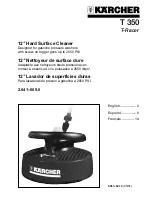
Page GB-5
Safety
■
Only parts corresponding to the orig-
inal appliance specifications may be
used for repairs. This appliance con-
tains electrical and mechanical parts
which are essential for protection
against potential sources of danger.
■
Check whether any stipulations of the
relevant energy provider concern the
connection of washing machines.
We recommend using a pulse-sensi-
tive residual-current device (RCD).
■
The appliance corresponds to protec-
tion class I and may only be connect-
ed to a plug with a protective conduc-
tor that has been installed properly.
When connecting, make sure that it
has the right voltage. You can find
more detailed information about this
on the nameplate.
■
If the mains plug is no longer acces-
sible after installation, an all-pole dis-
connecting device complying with
overvoltage category III must be
connected to the house wiring with a
contact gap of at least 3 mm; this in-
cludes fuses, circuit breakers and con-
tactors.
■
Do not operate the appliance with an
external timer or a separate remote
control system and do not connect to
a multi-socket
■
Keep the appliance, the mains plug
and the mains cord away from open
flames and hot surfaces.
■
Do not kink or pinch the mains cord
or lay it over sharp edges.
■
If the mains cord of the appliance is
damaged, it must be replaced by the
manufacturer, through customer ser-
vice or by a qualified specialist.
■
Do not put any objects in or through
the housing openings and also make
sure that children cannot insert any
objects through them.
■
Never pull the mains plug out of the
socket by the mains cord, always hold
the mains plug itself.
■
Never touch the mains plug with wet
hands.
■
Never immerse the mains cord or
mains plug in water or any other liq-
uids.
■
In the event of malfunction, and be-
fore cleaning and maintenance, dis-
connect the plug and/or disable/un-
screw the fuse.
■
Never clean the appliance with a
high-pressure cleaner or steam clean-
er.
■
Check the appliance regularly for
damage.
















































